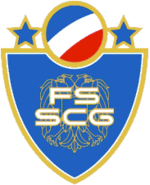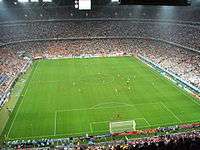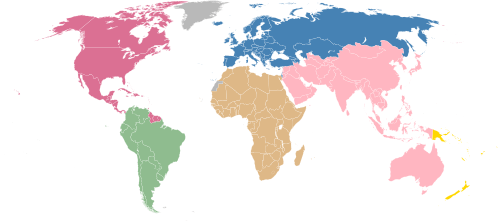Serbia and Montenegro national football team
 | |||
| Nickname(s) | Plavi (The Blues) | ||
|---|---|---|---|
| Association |
Football Association of Serbia and Montenegro (2003 - 2006) Football Association of Yugoslavia (1992 - 2003) | ||
| Confederation | UEFA (Europe) | ||
| Head coach | Ilija Petković | ||
| FIFA code |
SCG (2003 - 2006) YUG (1992 - 2003) | ||
| |||
| FIFA ranking | |||
| Highest | 6 (December 1998) | ||
| Lowest | 101 (December 1994) | ||
| Elo ranking | |||
| Highest | 4 (June 1998) | ||
| Lowest | 39 (June 2006) | ||
| First international | |||
|
(Porto Alegre, Brazil; 23 December 1994) as Serbia and Montenegro (Podgorica, Serbia and Montenegro; 12 February 2003) Last international as FR Yugoslavia (Stade de France, Paris; 20 November 2002) as Serbia and Montenegro (Munich, Germany; 21 June 2006) | |||
| Biggest win | |||
|
(Toftir, Faroe Islands; 6 October 1996) | |||
| Biggest defeat | |||
|
(Gelsenkirchen, Germany; 16 June 2006) | |||
| World Cup | |||
| Appearances | 2 (first in 1998) | ||
| Best result | Round of 16: 1998 | ||
| European Championship | |||
| Appearances | 1 (first in 2000) | ||
| Best result | Quarter-finals: 2000 | ||
The Serbia and Montenegro national football team (Serbian: Фудбалска репрезентација Србије и Црне Горе) was a national football team that represented the federation of Serbia and Montenegro. It was controlled by the Football Association of Serbia and Montenegro. For eleven years it was known as the FR Yugoslavia national football team when the two countries were called the Federal Republic of Yugoslavia, until February 2003 when the name of the country was changed to Serbia and Montenegro. In 2006, Montenegro declared its independence from Serbia, with the result that the country's football team was renamed as the Serbia national football team on 28 June 2006 with the Montenegro national football team created to represent the renewed state of Montenegro.
History
Prior to 1991
Post-1991
Slobodan Santrač era (1994–1998)
Although the Federal Republic of Yugoslavia was formed on 28 April 1992, its teams were banned from all international sporting events, including the national football team. Consequently, the national team did not play its first game as a new country before 23 December 1994, a friendly match played in Porto Alegre and in which Brazil won by the mark of 2–0. This was the first ever team composed of Serbian and Montenegrin players exclusively, while Slobodan Santrač, a former Yugoslavia national team player, was named the team's first ever manager. The next game was played only three days later, this time in Buenos Aires, resulting in 1–0 loss to Argentina. Despite two losses in two games, the team was honoured to play its first two games ever against such football powerhouses.
Also due to the United Nations international sanctions, the team could not take part in the 1994 FIFA World Cup qualification, nor the UEFA Euro 1996 qualifying process.
On 31 March 1997, the team recorded its first official win in history, a 1–0 friendly against Uruguay, simultaneously marking the team's first ever home game, played at Stadion Crvena Zvezda in Belgrade, and the first ever goal scored, courtesy of Savo Milošević. Slightly more than one year later, the team recorded its first ever win in a FIFA World Cup qualifying tournament in its first game in such a tournament, a 3–1 win over the Faroe Islands. Shortly after, the team also recorded its biggest win in history, once again against the Faroe Islands, 8–1. Yugoslavia finished second in Group 6, just behind Spain, meaning it had to go through the play-off system in order to qualify. Yugoslavia was paired up with Hungary, and what was believed would be a tough matchup turned out to be an easy win for Yugoslavia, 7–1 in Budapest and 5–0 in Belgrade, for an aggregate score of 12–1. This was enough to secure Yugoslavia its first ever FIFA World Cup appearance as a new country.
The 1998 FIFA World Cup seeding had Yugoslavia ranked in 21st position, but the Yugoslav national football team went to France as one of the shadow favorites for the World Cup. The New York Times stated that Yugoslavia could easily be a semi-finalist in that year's World Cup.[1] The justification for such an estimation was partially found in the names of the Yugoslav players, members of great European teams and proven footballers. The draw put the team in Group F alongside Germany, the United States, and Iran. Yugoslavia won its first game 1–0 against Iran thanks to a goal from defender Siniša Mihajlović. The next game was a draw for Yugoslavia. After leading Germany 2–0, last game's hero, Mihajlović, scored an unlucky own goal following a German freekick, and Oliver Bierhoff equalised at 2–2 with only about ten minutes to the match. Nonetheless, Yugoslavia responded in the next game against the United States and won 1–0 due to an early goal in Nantes. Yugoslavia made easy work of Group F, but despite an excellent record, the game against Germany would prove costly as Germany won the group thanks to a better goal difference.
Due to their second position, Yugoslavia saw itself face the Netherlands in the Round of 16. Yugoslavia entered in the match with a sole attacker, but its defensive tactics proved unsuccessful as Dennis Bergkamp put the Netherlands in front in the 38th minute. Immediately following the start of the second half, Yugoslavia pressured the Dutch, who inevitably conceded a header from Slobodan Komljenović. However, the turning point of this match was a penalty awarded to Yugoslavia after Vladimir Jugović was fouled in the penalty area. Predrag Mijatović's shot dazzled Edwin van der Sar, but not the crossbar, and the scoreline remained the same at 1–1. Such an event demoralized the Yugoslavs, as the Dutch took the initiative. In the late seconds of the game, as everybody was preparing for extra time, Edgar Davids shot towards the Yugoslav net from a distance of 20 meters and beat goalkeeper Ivica Kralj, to the pure disbelief of the Yugoslav players and fans. This marked the end of Yugoslavia's run in the 1998 FIFA World Cup, since there was not much time left to do anything.
Unlucky events forced Yugoslavia out of the tournament, but the team definitely demonstrated its great ability and proved it had a spot among the world's best teams. This was also reflected in the FIFA World Rankings following the 1998 FIFA World Cup, in which Yugoslavia was constantly ranked in the Top 10 for a long period of time.
Euro 2000
The draw for the Euro 2000 qualifiers saw many eyebrows raised as first-seeded Yugoslavia was drawn in a group with Croatia, thus marking the first games between the two teams after the breakup of Yugoslavia. The other teams in the group were the Republic of Ireland, Macedonia, and Malta. When the qualifiers began, the coach was Milan Živadinović, but in July 1999 he resigned and was replaced by Vujadin Boškov.
The team started with a 1–0 win over Ireland in Belgrade, before beating Malta 3–0 in Ta' Qali. The home fixture against the Maltese followed, but was moved to Thessaloniki, Greece due to the NATO bombing of Yugoslavia. The team nonetheless won 4–1. The first, highly anticipated match against Croatia took place in Belgrade shortly after the bombing ended, and was interrupted due to a power outage at the beginning of the second half, resuming after 43 minutes[2] and eventually finishing 0–0. A 2–1 defeat against Ireland in Dublin was followed by victories home and away against Macedonia (3–1 and 4–2 respectively), meaning that Yugoslavia needed to win its final qualifier against Croatia in Zagreb, or to draw with Ireland failing to beat Macedonia in Skopje, in order to qualify automatically for Euro 2000. In the event, Ireland conceded an injury-time equaliser, meaning that Yugoslavia's 2–2 draw with the Croatians was good enough.
The draw for the Finals placed Yugoslavia in group C along with Spain, Norway and another former Yugoslav republic, Slovenia. The Slovenians took a surprise 3–0 lead in the first game at the Stade du Pays de Charleroi, but three goals in six second-half minutes enabled Yugoslavia to secure a 3–3 draw. The team then beat Norway 1–0 in Liège, thanks to an early Savo Milošević backheel strike. The final group game, against Spain in Bruges, saw the Yugoslavs take the lead three times, before a Gaizka Mendieta penalty and an Alfonso Pérez strike in injury-time secured a dramatic 4–3 win for the Spaniards and top spot in the group. Yugoslavia nonetheless finished second, level on points with Norway but ranked ahead due to its victory in Liège. In each of the three games, the team had one player sent off (Siniša Mihajlović, Mateja Kežman, and Slaviša Jokanović, respectively).
In the quarter-finals, Yugoslavia was once again paired with the Netherlands. Unlike the last time, the co-hosts made easy work of Yugoslavia, winning 6–1 in Rotterdam with Patrick Kluivert scoring a hat trick.
One of the few bright spots of Yugoslav team in the whole tournament was Savo Milošević, who was crowned the joint top scorer of the tournament, alongside Patrick Kluivert. Both players scored five goals, although Milošević played one game fewer.[3]
Failure to qualify for 2002 World Cup
The 2002 qualifiers marked the first time that Yugoslavia failed to reach a major tournament ever since its return to the big stage after the UN sanctions. The problems started with the major political turmoil in the country as well in the Yugoslav FA, which prompted the new coach Ilija Petković to resign only after one game (2–0 away victory against Luxembourg).
Milovan Đorić took over the team, but under his leadership, the team managed only two draws (1–1 at home vs. Switzerland and also 1–1 away in Slovenia, in both games the opponents managed to equalise in late stages of the game) and a 0–1 home loss to Russia (which marked the team's first home defeat in official matches). After Đorić's resignation, a three-man commission, consisting of Dejan Savićević, Vujadin Boškov, and Ivan Ćurković, took over the coaching duties, until Savićević ultimately took over on his own. The team managed to bounce back with a draw in Russia and a win in Switzerland, but failed to defeat Slovenia in the penultimate game, thus ended the qualifiers in third position.
Ilija Petković era (2003–2006)

After Savićević's disastrous spell as coach of Yugoslavia, the country went under a political transformation, and Ilija Petković became the newly named Serbia and Montenegro's new coach. Initially, the team under his lead experienced dragging failure in the Euro 2004 qualifiers while competing for the first time as Serbia and Montenegro. Despite drawing both games against group favorites and eventual group winners Italy and winning both games against runners-up Wales, Serbia and Montenegro failed to qualify, mostly due to embarrassing 2–2 home draw and 2–1 away loss to Azerbaijan.
However, qualifying for the 2006 FIFA World Cup was a different story. Serbia and Montenegro began their 2006 World Cup campaign by finishing first with an undefeated record in their qualification group ahead of favourites Spain. The Serbia and Montenegro team also allowed only one goal in the 10 matches, the best defensive record out all 51 teams participating in qualification.
For the 2006 qualifiers, Serbia and Montenegro was drawn in a group with Spain, Belgium, Bosnia and Herzegovina, Lithuania and San Marino. Led once again by Ilija Petković as coach, Serbia and Montenegro played some impressive defensive football—the "Famous Four" defense, consisting of Nemanja Vidić, Mladen Krstajić, Goran Gavrančić, and Ivica Dragutinović, with Dragoslav Jevrić as goalkeeper, allowed only one goal in ten games, finishing first with a 6–4–0 record, ahead of Spain.
On 3 June 2006, following a referendum, Montenegro declared its independence from Serbia. As the World Cup was about to start, it was decided that the Serbia & Montenegro team that had qualified for the tournament would compete, with the split into separate teams representing the new countries of Montenegro and Serbia to take place once the team was eliminated from the tournament.
In the 2006 World Cup group stage, Serbia and Montenegro lost their opening game to joint group favourite, the Netherlands. The final score was 1–0 after Arjen Robben scored the only goal of the game. They also lost their second game to Argentina 6–0, Serbia and Montenegro's worst ever international result. With the team's two losses and with Netherlands and Argentina winning both their games, Serbia and Montenegro could no longer qualify for the knockout matches, and was playing for pride alone in their final group game against Côte d'Ivoire, who had also been eliminated. Despite having a 2–0 lead for much of the first half, the Elephants managed to come back and win 3–2, leaving Serbia and Montenegro with a disappointing 0–0–3 World Cup run.
After dissolution
A week after Serbia and Montenegro's final game against Côte d'Ivoire, the Football Association of Montenegro applied for separate membership to UEFA. The Football Association of Serbia was granted Serbia and Montenegro's place in UEFA and FIFA, with the new Serbia national football team playing its first game in August 2006 against the Czech Republic. The Montenegro national football team played its first international following admittance to UEFA against Hungary in March 2007.
Kit history
FR Yugoslavia
|
1994 Home
|
1998 WC Home
|
1998 WC Away
|
Euro 2000 Home
|
Serbia and Montenegro
|
2004 Home
|
2004 Away
|
2006 WC Home
|
2006 WC Away
|
World Cup record
- 1930 to 1990 – See Yugoslavia
- 1994 – Banned because of international sanctions due to the Yugoslav wars (as FR Yugoslavia)
- 1998 – Round 2 (as FR Yugoslavia)
- 2002 – Did not qualify (as FR Yugoslavia)
- 2006 – Round 1 (as Serbia and Montenegro)
European Championship record
- 1960 to 1992 – See Yugoslavia
- 1992 – Qualified, but banned because of international sanctions during Yugoslav wars (as FR Yugoslavia)
- 1996 – Banned because of the sanctions (as FR Yugoslavia)
- 2000 – Quarterfinals (as FR Yugoslavia)
- 2004 – Did not qualify (as FR Yugoslavia/Serbia and Montenegro)
Major competitions squads
World Cup
Euro
Coaches
- Slobodan Santrač 1994 – July 1998
- Milan Živadinović August 1998 – 1999
- Vujadin Boškov 1999 – July 2000
- Ilija Petković August 2000 – January 2001
- Milovan Đorić February 2001 – 6 May 2001
- 3-man commission: Dejan Savićević, Vujadin Boškov and Ivan Ćurković 6 May 2001 – December 2001
- Dejan Savićević December 2001 – June 2003
- Ilija Petković July 2003 – June 2006
References
- ↑ Vecsey, George (26 June 1998). "Sports of The Times; Scrapbooks Of History For the U.S". The New York Times.
- ↑ http://www.arhiva.serbia.gov.rs/news/1999-08/19/13984.html
- ↑ "Leading goalscorers". UEFA.com. Union of European Football Associations. 2 July 2000. Archived from the original on 11 July 2000. Retrieved 12 July 2012.
External links
Note that the RSSSF pages are still slightly outdated with regard to the renaming of the last Yugoslavia and the succession issues.
